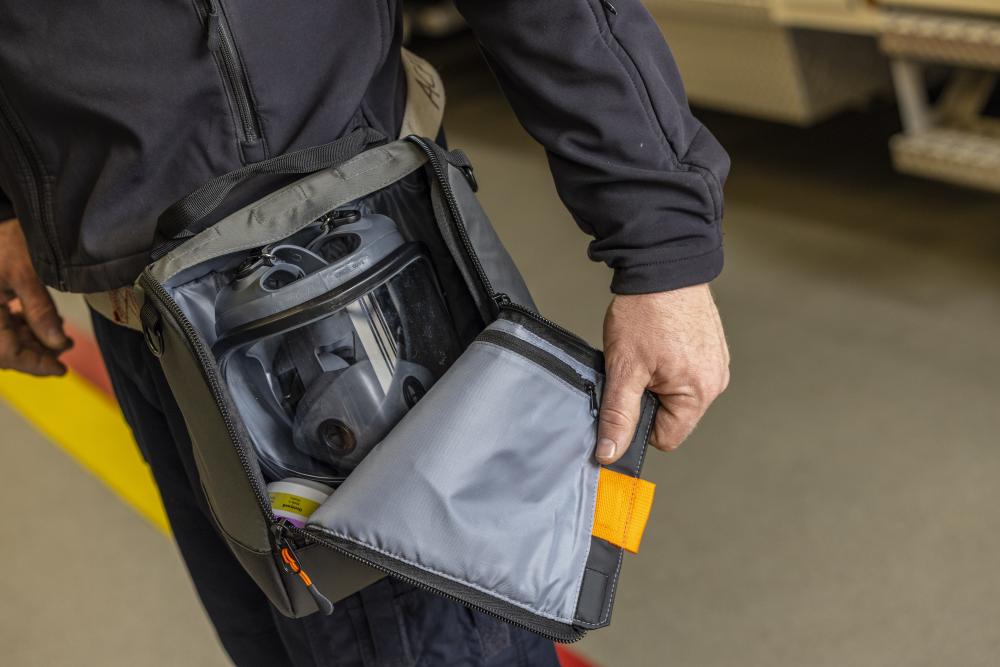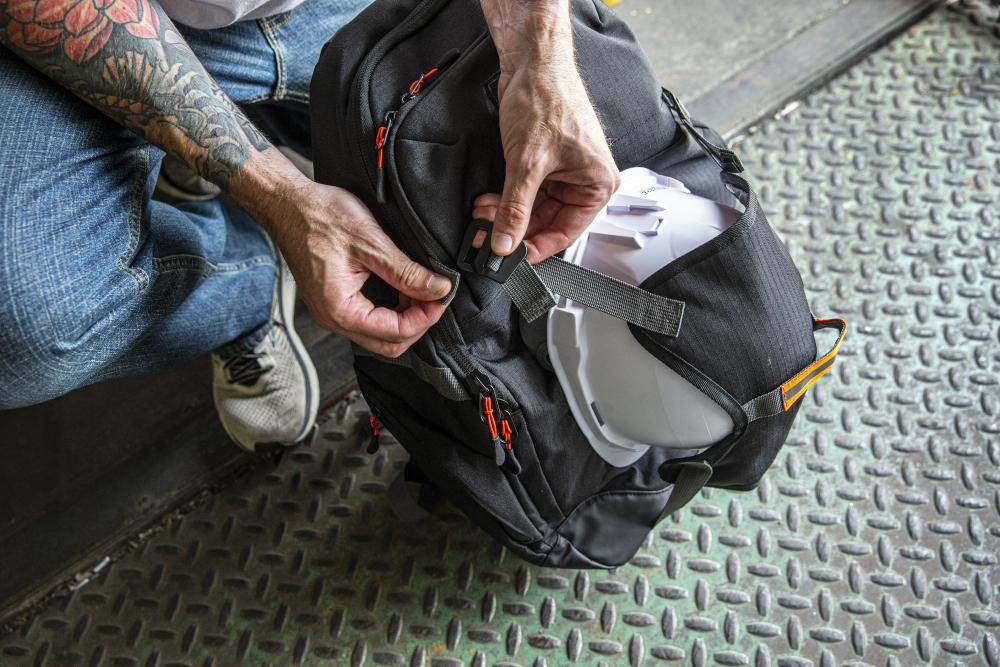Don’t Let Your PPE Go MIA: Store It & Use It

Let’s examine the case of missing personal protective equipment (PPE). A hard case to crack with a long history.
- Exhibit A: In one survey, almost every single worker polled—98%—said they had seen a peer working without required PPE. And 29% said this happened numerous times.
- Exhibit B: Three out of five workers who suffered eye injuries did not wear eye protection at the time, or the wrong kind of eyewear for the hazard, according to a government study.
- Exhibit C: About one in five workers fail to use hearing protection and respiratory protection when required, according to studies. With five million workers needing respiratory protection, according to OSHA, that’s one million workers walking into exposures without masks.
PROPER STORAGE OF PPE
How to crack the case of PPE gone MIA? PPE personal storage equipment boosts compliance by connecting—literally—the worker to his or her PPE. It could be via a backpack, a shoulder bag, a hand-held duffel bag or drawstring bag.
We hear a lot of chatter these days about the “connected worker.” Outfitted with smart technology wearables, the workforce can have real-time data connectivity sending reports and alerts to safety officers and co-workers. PPE storage equipment creates physical, practical connectivity. PPE that is stored close at hand is less likely to be neglected when a worker is rushed, tired, or thinking, “Hey, this job is fast and easy, done it a thousand times.”

PPE programs are developed with good old sweat equity. You conduct a hazard assessment. Identify when and what type of PPE is needed. Workers are trained how to use, clean, inspect and store PPE. PPE is purchased to match the at-risk hazards. You try to boost compliance with PPE that’s stylish, comfortable, and the right fit. Often workers are asked for their input on what they want. After putting in this time and effort, of course you want to see PPE where it belongs—on your workers.
Personal PPE storage units help the compliance cause. Give workers PPE storage capability—and capacity—and you send a message. PPE is important. It’s mandated by OSHA regs and company policies. It needs to be protected from damaging elements. Storage units organize PPE for grab-and-go use with internal dividers, pockets inside and out, large compartments for heavy gear. Easily accessible whenever needed thanks to easy transport using padded shoulder straps, grab handles and backpacks. Instant access eliminates excuses.
OSHA PPE STANDARD // What do the experts say?
OSHA of course accepts no excuses when it comes to non-compliance. Standard 1910.132—general requirements for personal protective equipment lays out the mandate in a long and winding 77-word sentence, a classic of regulatory text:
“Protective equipment, including personal protective equipment for eyes, face, head, and extremities, protective clothing, respiratory devices, and protective shields and barriers, shall be provided, used, and maintained in a sanitary and reliable condition wherever it is necessary by reason of hazards of processes or environment, chemical hazards, radiological hazards, or mechanical irritants encountered in a manner capable of causing injury or impairment in the function of any part of the body through absorption, inhalation or physical contact.”
RESPIRATOR STORAGE DO’s & DONT’S
Respirators have especially stringent OSHA storage requirements. In November 2020, OSHA listed improper respirator storage as a common COVID-19 citation. Standard 1910.134(h)(2)(i) requires respirators to be stored in a way that protects them from damage and contamination and prevents facepieces and respirator valves from being deformed.
Respirators must be inspected for damage before each time they’re used. Giving respirators the once over is easy when pulled straight from a lightweight personal storage carrying bag. Expensive respirators are protected by durable tarpaulin, magnetic closures, buckles and heavy-duty zippers. With plenty of interior room it’s less likely that respirators will have holes, cracks, dents, tears and scratches. Less likely facepiece edges will be rippled or distorted. Those metal nose clips over the bridge of the nose on disposable respirators will stay in place. Plus, half-face and full-face respirator masks can be stored without having to remove filters. There are also heavy-duty nylon fire-fighter self-contained breathing apparatus (SCBA) mask bags with spring-loaded steel clasps to attach the SCBA bag to bunker gear, coat or belt.

Personal PPE storage promotes organized pre-planning before going out on the job. Respirator parts from different manufacturers won’t be mixed when bags are carefully packed. Filters and masks will be compatible; certified for use together; and the approved filter for the hazard will be ready for use. Stretch elastic interior pockets store extra respirator filters, mask instructions and other small accessories.
Respirators are especially mission critical PPE. This is definite potentially life-saving gear against highly toxic contaminants and atmospheres immediately dangerous to life and health. For respirators to be effective—and they must be—proper cleaning and storage is essential. Dust, sunlight, heat, extreme cold, excessive moisture and damaging chemicals and contaminants can rob respirators of their life-saving capabilities. Storage bags specifically designed for respirators keep these life-savers clean, dry, out of the elements and in their natural shape. That seals the deal for getting the proper face fit.
Respirator storage units mean no more worries that on hot and humid days respirators might be removed and hung on nail next to a pesticide container. Or the respirator is tossed on the dashboard of a truck parked in broad sunlight.
STORING HARD HATS PROPERLY
Backpacks with an exterior pocket carry hard hats throughout a shift using padded shoulder straps and breathable mesh lining to prevent overheating PPE packed inside. OSHA recommends that safety headgear be stored out of direct sunlight, which can damage helmet integrity. Loss of surface gloss, chalking and flaking on the shell or brim of a hard hat are signs that the hat may have been exposed to excessive heat or sunlight and should be replaced. Comfortable backpacks with an exterior pocket for hard hat storage block those damaging sun rays.

HOW FALL PROTECTION SHOULD BE STORED
Fall protection harnesses should be stored hanging, flat or neatly folded to prevent unnecessary wear. Specially-designed PPE storage compartments can accommodate this and keep harnesses dry and away from temperature extremes. Typically, manufacturers recommend that harnesses be dried and stored away from direct sunlight and heat. Hello personal PPE storage.

PPE STORAGE // The General Rule of Thumb
OSHA doesn’t have specific guidance on storing other types of PPE, but check out the "Handbook of Occupational Safety and Health," edited by S. Z. Mansdorf, CIH, CSP. It recommends the following general practices for storing PPE:
- Keep the storage area clean and dry.
- Keep the PPE away from direct sunlight when stored.
- Train users on how to store PPE correctly.
- Consult the manufacturer's instructions for more specific guidance.
Personal PPE storage units check off all these boxes.
CHANGING YOUR MINDSET WITH PPE STORAGE
Typical reasons for PPE non-compliance are as old as the hills:
- “I forgot it.”
- “I didn’t know I needed it.
- “I won’t get hurt. Never have. Yeah, I’m Superman.”
- “I don’t have the time.”
- “It’s a hassle to put on.”
- “What do I do with it when I’m not using it?”
PPE personal storage units make these excuses moot by giving workers a sense of PPE ownership—and accountability. Respirators, gloves, hearing protectors, safety glasses, hard hats, fall harnesses, hi-vis vests, along with small tools, even cell phones, water bottles and personal ID cards, aren’t left in a locker. Or in the back of a truck, on the dashboard, or in the tool crib. PPE needed for the job at hand is pre-selected before a shift on a construction site, oil field, in a mine or a manufacturing facility. It’s organized into internal dividers, exterior pockets, with plenty of room for larger PPE such as safety vests, hard hats, fall protection and full-face respirators. There’s nothing haphazard about how PPE is sorted for quick and easy use.

GIVE YOUR PPE SOME LOVE
Yes, PPE deserves personal care. We’re talking about protecting vital senses and organs—hearing, vision, lungs and the brain. Keeping all your fingers and both hands. Defying gravity with fall protection gear.
PPE personal storage equipment—respirator bags, jobsite backpacks with hard hat storage, work gear duffel bags, SCBA for fire-fighters, and drawstring closure fall protection gear bags—are rugged, tear-resistant and water-resistant, giving your PPE protection and respect it warrants.
But too often PPE doesn’t get that love. How often do you pass a work site, could be roofing, trenching, construction, landscaping, an open manhole, you name it, and see respirators dangling around the neck, safety glasses pushed up on the forehead, work gloves in back pockets, no fall protection gear in sight?
Personal storage capability protects and transports daily use PPE, especially for workers regularly traveling to different job sites. It won’t be left behind any more than cell phones, house keys, ID badges and cards, wallets, gym bags, lunch and snacks, water bottles, briefcases for office work or evening classes. You can change attitudes and behaviors about using PPE that goes beyond training, policing, monitoring, rule books and discipline. How? Just check out Arsenal® PPE storage products.

